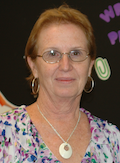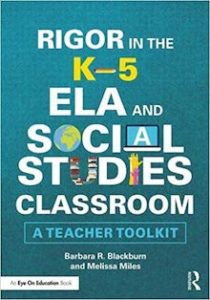Redefining Rigor for ELA and Social Studies
Rigor in the K-5 ELA and Social Studies Classroom: A Teacher Toolkit
By Barbara R. Blackburn and Melissa Miles
(Routledge/Eye On Education, 2020 – Learn more)
Reviewed by Linda Biondi

Barbara R. Blackburn and Melissa Miles, two veteran teachers with experience, know-how, and a desire to help teachers and students, have co-authored a book that will assist both ELA and social studies teachers to effectively add rigor to their teaching toolkit (without breaking into a nervous sweat!).

- It’s not doing more work,
- or doing more homework,
- or purchasing a new program or textbook,
- or starting from the beginning, or
- or totally changing your curriculum.
What is rigor? “Rigor is creating an environment in which each student is expected to learn at high levels; each student is supported so he or she can learn at high levels; and each student demonstrates learning a high level.” (Blackburn, 2012)
We need to increase rigor in our schools to prepare our students for life. It’s what exemplary teachers naturally do. As educators, we know how critical it is for students to feel safe and respected in the classroom environment. From the first time they set foot in the classroom as a preschooler or kindergartener, they want to learn. Blackburn and Miles provide research-based strategies to keep that desire for learning alive.
As I continued to read, I was reminded how important is for our students to develop questioning skills. I also thought about some of the social studies and ELA projects that I had given my own students. Did I give them a chance to think and investigate, or was it an “arts and craft project”? As you can see, this book prompts the reader to reflect on his/her teaching to help our students become more critical thinkers and citizens.
What you will find
The book is divided into four areas: environment, expectations, support, and demonstration of learning. Chapters 1-3 examine ways to increase rigor in the classroom with recommended strategies to ensure student success.
Chapter four (Support and Scaffolding) focuses on strategies that will support our students as they learn to become more complex thinkers and more confident as they begin to challenge themselves to approach more complex tasks.
Chapter five (Demonstration of Learning) provides a variety of resources and ways that students can demonstrate their learning at higher levels such as Jigsaw/Expert Groups, Literature Circles, and Virtual Reality.
Chapter six concentrates on assessment, both formative and summative. The authors request that you critically look at your current assessments to determine where you can make them more relevant and begin to develop student ownership. By applying these strategies, the students become aware of what is expected of them, but most importantly, feel ownership of their learning.
I found the book easy to read and reflective of current educational practices. I especially enjoyed learning more about Genius Hour and how to effectively integrate this liberating concept into the classroom.
The authors provide technology resources to supplement each section, such as technology resources to support Genius Hour: (Kiddle, Wonderopolis, Wizard School, Educurious, The Knowledge Compass).
How collaboration and rigor work together
There is no doubt in my mind that teaching is time consuming, often difficult, and sometimes overwhelming as new initiatives roll out. But teaching is the most rewarding profession around…especially when you have a chance to collaborate with others, sharing your joys, frustrations, and goals. The authors state it well. “An important part of raising the level of rigor in your classroom is collaborating with other teachers.” (p. 149)
One particular area in the final chapter, “Collaborating to Improve Rigor,” resonated with me. “Focus on Student Data.” At first, I thought…data! Enough of that. I’ve sat through enough faculty and Board of Education meetings where the focus of the meeting was to examine why we were doing “poorly” in specific curriculum areas.
But the authors focused on a different and more meaningful kind of data: examining and evaluating student work samples to discuss, think about, and reflect upon how we can best meet our students’ needs. “Is the work surface-level understanding or deeper level? What does the work of the student tell me about the assignment? What do I need to adjust for future assignments?”
Reimagining the buzzword
Blackburn and Miles provide a number of easily implemented ideas that can be used in the ELA and Social Studies Classroom to increase rigor. All through the book are examples, strategies, anecdotes, ideas, and research that will assist readers as they work to increase rigor in their daily teaching repertoire.
The authors are aware of the problems that teachers face and provide easily implemented solutions along with some thought provoking questions for the reader to ask himself/herself. Educators have the added benefit of being able to use this book to monitor their own progress as they add rigor to their teaching, and in turn make their instruction more relevant.
I definitely recommend this book for ELA teachers, Social Studies teachers, and administrators. Don’t be afraid to ask a colleague to read the book along with you or give you input into your lessons or curriculum. Don’t let the buzzword “Rigor” scare you! Once you begin reading the book, you won’t want to put it down (except to jot ideas to use in your teaching).
After teaching fourth and fifth graders for 41 years, Linda Biondi is supervising preservice and student teachers at The College of New Jersey and Rider University. She has co-facilitated summer writing institutes in conjunction with the National Writing Project and volunteers for two service organizations: Homefront and Dress for Success of Central New Jersey – with missions to end homelessness and empower women to achieve through economic independence.






























